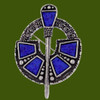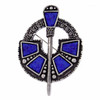Description
Tara Large Round Blue Glass Stone Antiqued Penannular Stylish Pewter Brooch
Stylish Pewter Brooch
Antiqued Penannular Brooch
measures 54.00mm (2.12 inches) x 76.00mm (2.99 inches)
Tara Penannular Design
This Tara Large Antiqued Penannular Brooch is expertly crafted with beautiful Stylish Pewter. The true penannular brooch is especially nice for ladies' dress wear, on a sash at the shoulder, on a fine scarf or shawl, or on a kilted skirt (instead of a long pin). The brooch also features give Lapis Lazuli coloured glass stones.
This brooch measures approximately 54.00mm (2.12 inches) x 76.00mm (2.99 inches). Each coloured glass stone is different so there may be variations in the piece that you do receive. Secures to garment by way of pin with locking, safety catch. Supplied in a satin and velvet gift box.
Have you seen the other matching pieces in my store ? Come and look today.
This handcrafted Brooch will become family treasures that will last through the ages!
Please be advised that your item needs to be cast and made before it can be sent to you. Please allow for sufficient time for your order to arrive.
Perfect for any occasion. This is a gift that will be proudly worn by any member of your family.
Questions welcome at anytime, my door is always open for assistance.
PENANNULARS
The very first brooches of this kind date back to the eighth century. The ancient Celtic people were the first to devise a way of pinning garments together. The Penannular or open ring brooch is among the most ancient of jewellery worn with articles of clothing. In ancient times, brooches were merely used as fasteners to hold clothing together, the Celtic people used them to fasten their cloaks.
The original brooches were used much like the modern day safety pin. Penannular brooches, used as cloak pins, were worn by the Celts in Britain from about the third century into early Christian times. Worn at the shoulder or breast, the brooches were as small as an inch in diameter, or quite large.
Some were plain bronze, iron or copper, and some jewelled and decorated with gilt, but all had one thing in common: a long loose pin that could slide around the ring. Penannular means almost a ring. Some were pseudo-penannular, i.e., made to look like true penannulars, except that the opening, although indicated, was closed.
To use a true penannular gather a fold of fabric, bring the pin through from back to front through the opening, and then turn the ring to keep it on firmly. Sounds complicated? It isn't, and besides, six centuries of Celts did it to keep their cloaks on.















